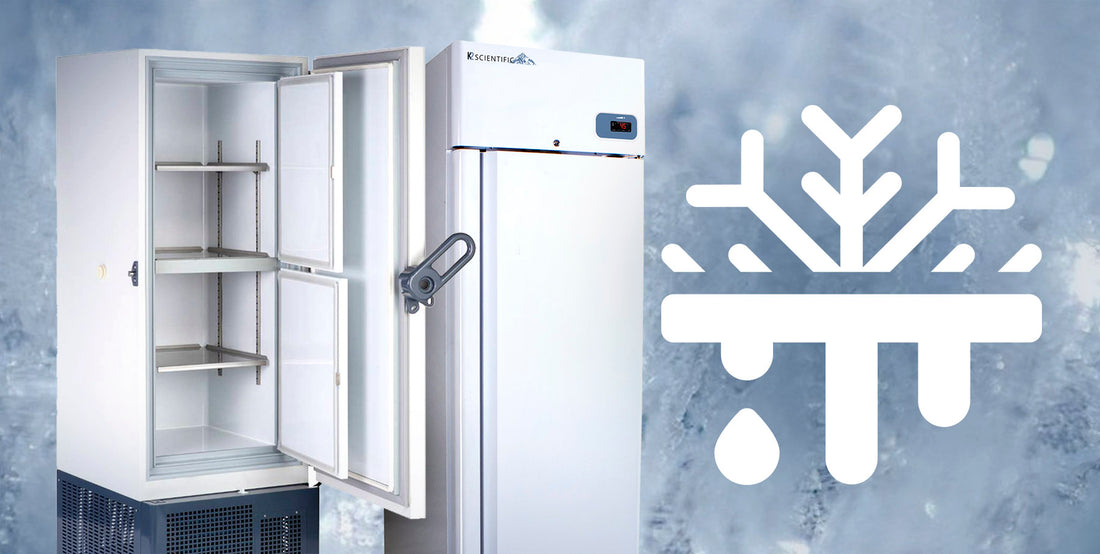Lab refrigerators are important fixtures in medical facilities, and protecting your facility’s contents with the right refrigerator is essential. When storing temperature-sensitive medical material, you can’t use just any refrigerator to do the job. Simply looking at how your samples appear is an unreliable indicator of how potent they are. Therefore, if you’re purchasing medical refrigerator units for your facility, you must keep defrost cycles in mind. Preventing your materials from spoiling will save you time and money, as you won’t need to replace damaged vaccines or samples.
Buying the proper refrigerator and storing your samples within ensures they’re safe and potent. Just as residential and commercial refrigerators are distinct, there’s a huge difference between manual and automatic medical-grade refrigerators. We will explain the differences between manual defrost and auto-defrost units below.
Manual
During the compressor’s regular on-and-off cycle, defrost routinely occurs within a manual unit. Manual defrost units have advantages; however, the disadvantages are worth noting.
Pros
Unlike auto-defrost units, the good news is that there are no temperature spikes with a manual unit. Additionally, there is no fan-forced air in a manual unit, meaning the contents in your refrigerator should not dry out. Essentially, your facility’s contents will be safe in this unit.
Furthermore, lab personnel have total control over a manual unit’s defrost cycle; they turn off and unplug the unit before defrosting it.
Cons
The cold air circulates through the walls of the unit. It does this through copper tubing, and it cools from the outside in. Thus, when a door opens, the unit doesn’t respond immediately to cool the inside because the cooler temperatures are cool on the outside. The coldest areas within the unit will be next to the walls and toward the bottom.
Because manual medical refrigerators don’t have cycling condensers or fans, facilities must remember to periodically remove frost and ice buildup on the sides of the unit. Facility members will also need to clean any condensation pooled at the bottom of the unit.
Defrosting and cleaning the refrigerator is going to take some planning. You’ll need to transfer your samples to another unit while you thaw the unit out. Additionally, you should not place contents back in your refrigerator until it reaches the proper temperature. Make sure to allow enough time to complete the entire process.
Additionally, when facility workers need to remove samples to defrost the unit, there comes a temperature fluctuation risk. Constantly opening and closing the unit doesn’t make your samples any good.
Automatic
An automatic or frost-free unit features computerized temperature control, offering convenience to busy facilities. Auto-defrost units provide several advantages, but there are a few disadvantages that your facility should keep in mind.
Pros
An auto-defrost unit is great for storing products generally unaffected by temperature changes. However, if you need to stow away sensitive materials, your facility should simply ensure the contents are stored in airtight containers.
Plus, you don’t have to relocate products to other units as you defrost. Luckily, defrost cycles occur more quickly in an automatic unit. This is because these types of units use a heater to defrost their condenser coils.
This refrigerator offers a generally uniform temperature because chilled air circulates throughout the unit. However, you may experience temperature spikes when using this unit. Because cycling happens every eight hours, there may be slight fluctuations as the compressor turns on and off.
Cons
With a more advanced unit, you’re going to end up using more power. Additionally, you’re likely going to be paying more for an auto-defrost unit than a manual defrost unit, especially if you’re buying a large appliance.
Because fan-forced air is constantly blowing in an auto-defrost unit, it’s possible that the unit’s contents may dry out. This is why it’s important that you properly cover your samples for storage. You’ll also notice variations in interior temperatures and cycle durations for auto-defrost units. Because these variations simply depend on the design of the unit, you’ll need to be cautious when storing temperature-sensitive materials.
Of course, the unit you use is entirely dependent on the application. In other words, you should buy a unit that meets your temperature needs. Whether you’re storing vaccines, pharmaceutical products, or blood samples, you’ll need to use the appropriate cycling to avoid compromising your lab materials. Take vaccines, for example—they must be stored in the ideal conditions in order to retain potency. To learn more information about how your facility can properly store vaccines, you’ll need to refer to the CDC’s Vaccine Storage and Handling Toolkit.
It’s apparent that both types of units have their benefits and drawbacks, so the unit you prefer for your facility is ultimately your choice. Assess your needs before buying your unit; determine the type of medical-grade refrigerator you need, and then consider the space available, the unit’s size, and your facility’s budget.
When you’re ready to buy a unit, remember to never purchase consumer refrigerators for lab use. Dorm-style and household refrigerators are going to operate differently from purpose-built refrigerators, such as lab and pharmaceutical units. In addition, if facility workers store food and samples in the same unit, they’re putting the medical materials at risk. When it comes to correctly storing your facility’s medical contents, your storage units need to be hygienic; to prevent cross-contamination, you should ideally consider units that feature separate compartments.
K2 Scientific offers a wide selection of top-selling medical refrigerators and freezers. We proudly offer both manual defrost and auto-defrost refrigerators and freezers. All units are CDC and VFC-compliant; no matter the refrigerator or freezer you choose, you can trust the quality.
We make it easy to purchase the right unit for your facility. Simply select the refrigerator or freezer you want, and we’ll ship it free within 24 hours. You also receive a two-year full replacement warranty on the unit you purchase. Select your facility’s new medical-grade refrigerator today. If you have questions, don’t hesitate to call us at 1.800.218.7613.
